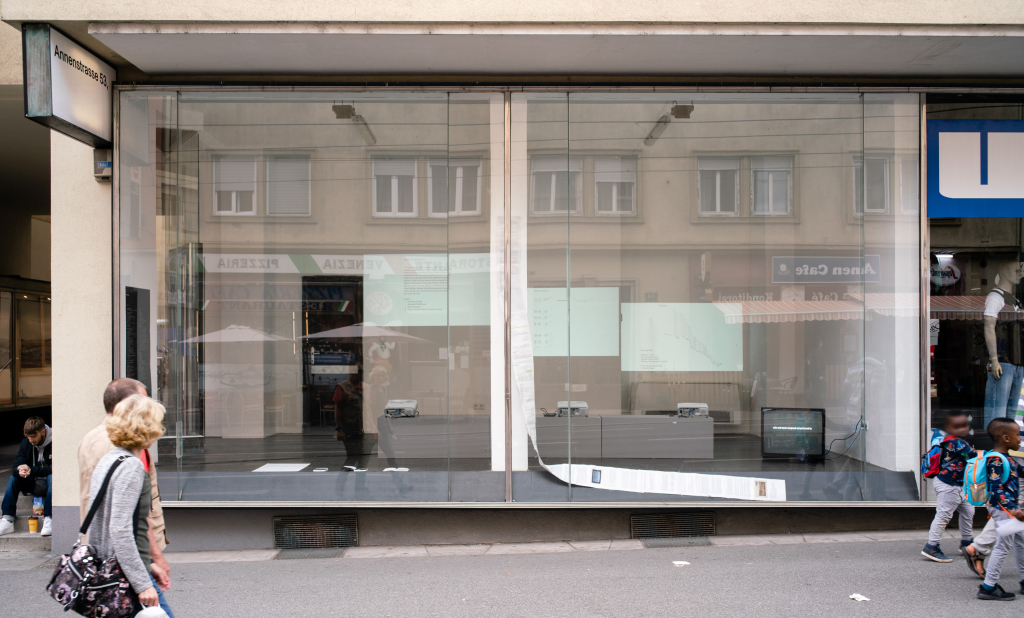The installation Secret Proof and the associated book by Nina Valerie Kolowratnik forms part of the exhibiting project Annenstrasse 53, which currently also includes works by Ariella Aïsha Azoulay and works in progress from two courses at IZK, TU Graz: the sound archive evolving within the course Trembling Streets: Investigative Materialities in an Apocalyptic World led by Philipp Sattler and the script developed by students within the course, Through the Looking Glass, the Realities We Found There led by Rose-Anne Gush.
Secret Proof challenges the conditions under which Indigenous rights to protect and regain traditional lands are currently negotiated in Western legal frameworks. Kolowratnik’s work responds to the urgent need for alternative modes of evidentiary production by introducing a system of architectural drawing and notation that is embedded in Jemez Pueblo’s system of cultural secrecy.
Today, most Western legal forums utilized by Indigenous communities for recognition of their rights continue to employ evidentiary rules that do not allow for Native truths to be accepted as “reliable” evidence. When tribes are asked to provide proof of their traditional connection to the land, what Western legal forums accept as documentation does not truly represent or respect tribal culture and traditional formats of knowledge transfer.
Kolowratnik’s research focuses on the double bind Pueblo communities in the American Southwest are confronted with when they become involved in a legal effort to reclaim and protect ancestral lands, since the process of producing evidence runs counter to their structural organization around oral history and cultural secrecy.
The spatial notational systems developed by Kolowratnik with the support of Hemish people, members of Jemez Pueblo in northern New Mexico, are an attempt to produce evidentiary documentation that communicates Native truths in Western courts while respecting demands on secrecy. These systems also attempt to instigate a dialogue where there currently is none, deconstructing the fixed opposition between secrecy and disclosure within Western legal systems.
Kolowratnik’s main collaborators for the drawing series shown in this exhibition were Pah-Tow-Wei Paul Tosa and Sée-Shu-Kwa Christopher Toya, as well as Antony Armijo and Steven Gachupin.
Nina Valerie Kolowratnik is an architect, researcher, and PhD in Law candidate at the Human Rights Centre at Ghent University. Her research focuses on Indigenous peoples' knowledge in settler-colonial legal and human rights frameworks, forced migration and notational systems. She’s the author of the book The Language of Secret Proof: Indigenous Truth and Representation (Sternberg Press, 2019). Since 2014 she has been teaching on borderlands, migration and counter narratives at Columbia University GSAPP and Vienna University of Technology. In 2016 Kolowratnik received the Outstanding Artist Award in Experimental Tendencies in Architecture by the Austrian Federal Chancellery. Kolowratnik holds an MArch from TU Graz (2010) and a MS in Critical, Curatorial and Conceptual Practices in Architecture from Columbia University GSAPP (2013)
Annenstrasse 53, is an exhibiting space which aims to establish a clear division between an Exhibition as a representational form, deeply rooted in colonialism and embodying imperial modes of representation, and Exhibiting as a continuous, open-ended process, characterised by the deliberate refusal of temporal and spatial closure. Exhibiting takes place in a moment wherein it is not objects and works that are exposed, but rather, we expose ourselves to the complex questions that are given by our historical conditions. By slowly adding and subtracting artefacts, publications, artistic works and conversations, we evoke exhibiting as a continuous process which aims to establish discourses in flux.
The project Annenstrasse 53, run by Das Gesellschaftliche Ding. Kunst, Architektur und Öffentlichkeit, is part of the KUNSTRAUM STEIERMARK fellowship programme of Land Steiermark and supported by steirischer herbst, Land Steiermark, Abteilung 9 Kultur, Europa, Sport, and the City of Graz, Kulturamt.



